Indus Saga is romance of diverse cultures, living through a rich timeline of historical past. The colorful and lively nature of its people has kept the land alive with traditions followed through generations. There are many racial groups of varied origins merging into one great social fabric living harmoniously through centuries. Every community lives with its own traditions and customs one can see this interesting spectacle at the annual gatherings of a festival or a religious event. We see minstrels singing on the tap of drum or the magic of alghoza swirling into rhythm of ultimate trance. A shrine is the best sight to observe gathering of folks from every walk of life from every part of countryside. The other side of Indus river communities is their colorful art work of ethnic production from daily life tools, the famous fabrics still continue to add colors of centuries one can observe traversing into a goth or rural home turns out be a surprise for a traveler. Above all hospitality is a genuinely character of these simple and honest folks. On our tour we come across ethnic cultures, rich traditions and customs give us insight into the life of local communities whose resonance continues from thousands of years.
Itineraries
Day 01: Arrive Karachi – flt
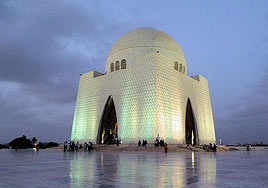 Meeting on arrival assistance and transfer to hotel. Later in the afternoon orientation tour of Karachi – see the main highlights of the metropolis to include the mausoleum of Quaid-e-Azam, Merewether Tower, Mohatta Palace. Later visit National Museum of Pakistan which houses priceless artifacts and seals Indus Valley Culture and also houses some masterpieces of Gandharan Culture. The ethnic gallery is of great interest throwing light on multi-culture communities of Sindh. Later we shall visit Empress Market full of local folks buying daily consumption products. o/n
Meeting on arrival assistance and transfer to hotel. Later in the afternoon orientation tour of Karachi – see the main highlights of the metropolis to include the mausoleum of Quaid-e-Azam, Merewether Tower, Mohatta Palace. Later visit National Museum of Pakistan which houses priceless artifacts and seals Indus Valley Culture and also houses some masterpieces of Gandharan Culture. The ethnic gallery is of great interest throwing light on multi-culture communities of Sindh. Later we shall visit Empress Market full of local folks buying daily consumption products. o/nKarachi:
The sprawling metropolis of Pakistan, Karachi rose from a tiny hamlet of 20 to 25 fishing huts. A Dutch ship wreck brought to light a new port for expansionist colonials. By early 19th century Karachi was well under the control of British who kept expanding their control in post Mughal India. British India Company slowly expanded the sea ports all around knocking out the French, Portuguese and Dutch colonials. Soon after the landing of British, Karachi saw a large number of immigrants from the coastal region of Baluchistan in search of living while another community was of Business migrants from Bombay who saw encouragement from the British. This saw rise of multicultural and multireligious settlers thronging to the new land of hope. Soon Karachi’s gained importance as a convenient port town by the maritime business community Finding the new port as a central base for reaching out to Gulf and Southeast Asian port towns. By the turn of 19th century Karachi was transformed into a busy port town with numerous new buildings of varied architectures in Gothic and Victorian styles introduced during the British era. Karachi also was an important terminal on the air routes between Europe and Asian cities. Soon after the independence in 1947 Karachi become the capital of new Republic of Pakistan and this was the time great migration of people which saw division of India. A large number of educated class working in the British bureaucracy became the Govt functionaries. Later in the year 1960s the capital was shifted to new Islamabad however the importance of Karachi remained as the financial hub of Pakistan which is true till today. Karachi is 20th among the largest cities of the world with a population over 14 million soul and has grown into a great multi ethnic metropolis. In today’s modern spirit Karachi’s importance has grown multilateral with huge opportunities for the global business community.
Day 02: Karachi – Thatta – Hyderabad – 190 kms
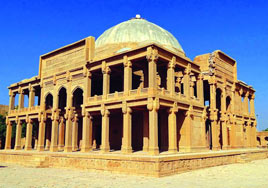 This morning we shall depart for Hyderabad on the old road – our first stop will be at Chaukundi tombs. It was a smaller necropolis but known for its floral and geometric patterns on tomb stones. After a quick visit we leave more closer look at such graves in Makli later, we move towards Bhambore archaeological site at the mouth of River Indus. Later we shall proceed to Thatta visiting Makli tombs and 16th century Shah Jahan mosque in the city. Our last stop will be the city of Hyderabad. o/n
This morning we shall depart for Hyderabad on the old road – our first stop will be at Chaukundi tombs. It was a smaller necropolis but known for its floral and geometric patterns on tomb stones. After a quick visit we leave more closer look at such graves in Makli later, we move towards Bhambore archaeological site at the mouth of River Indus. Later we shall proceed to Thatta visiting Makli tombs and 16th century Shah Jahan mosque in the city. Our last stop will be the city of Hyderabad. o/nBhambore site: (WHS pending)
Not very far from the city limits of Karachi, Bhambore has been recognized as an important site where once stood a fortress guarding the mouth of River Indus throws light on the strategic importance of the site which may have been on the route of Admiral Nearchus of Alexander the Great though while sailing to find the mount of River Indus though nothing is mentioned by the classical historians. But it has recognized as the site could be as old as 1st century BC of Scytho-Parthian rule era. There is a site of an old mosque ruins dating 8th AD when Arabs attacked the fortress held by local Raja. This could be the oldest mosque site and introduction of Islam from the south by sea route. This is very interesting with a small archaeological museum located on the site.
Thatta Makli Necropolis: (WHS)
This is one of the largest necropolis with more than half million tombs of kings, queens, generals, poets, saints and singers found their resting place dating from 14th to 18th century through different ruling dynasties. The local ruling dynasties of Rajputs and also some are identified as of Turkic and Persian origins. The unique aspect of these tombs is highly skilled fret work in red sandstone and local queried stones but in the later part of 18th century brick was in use with alabaster plaster. The floral and geometric work carved in red sandstone is worth noticing and shows how amazing was the love and association of the parted soul with their kin in royalty or the aristocratic families. This place is of immense importance as it does not lie very far from Indus river and must have been of great importance during the heydays of local ruling class doing trade with other states falling by River Indus.
Day 03: Hyderabad – Mithi - Hyderabad
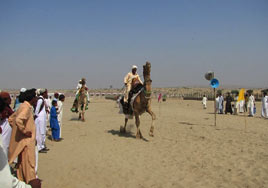 This will be an exclusive day spending time with local ethnic communities – we shall travel to Mithi and then to the nearby villages of Thar Parkar least on the tourist map. Thar desert is extended into India as well however the part on Pakistan is less developed and local culture is well protected and survives to its nature through all the years of massive development in the nearby country side. We shall make visit of Naukot – we shall see the old fort of Talpurs built in early 19th century for protection against the inroads of hostile tribes Later proceed to Mithi more deeper in the desert – an occasional stop to see a roadside village Or a nomadic caravan. In Mithi we shall visit Shiv Temple in Mithi, the colorful bazaar selling tribal embroidery worth seeing. Later return to Hyderabad.
This will be an exclusive day spending time with local ethnic communities – we shall travel to Mithi and then to the nearby villages of Thar Parkar least on the tourist map. Thar desert is extended into India as well however the part on Pakistan is less developed and local culture is well protected and survives to its nature through all the years of massive development in the nearby country side. We shall make visit of Naukot – we shall see the old fort of Talpurs built in early 19th century for protection against the inroads of hostile tribes Later proceed to Mithi more deeper in the desert – an occasional stop to see a roadside village Or a nomadic caravan. In Mithi we shall visit Shiv Temple in Mithi, the colorful bazaar selling tribal embroidery worth seeing. Later return to Hyderabad.o/n
Day 04: Hyderabad – Bhit Shah – Hala – Sehwan – 188 kms
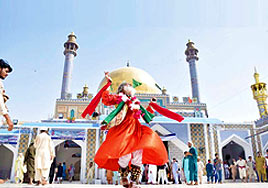 Morning we shall depart for Sehwan – enroute our first stop will be a detour to the town of Bhit Shah to visit the shrine of Shah Abdul Latif Bhitai known for its exclusive tile work is one the best examples of respect paid by the local ruler building an exclusive tomb. Later at a shorter distance life the town of Hala – known for its ceramics in Persian blue – we shall visit a local work shop to see making of local pottery works. Next proceed to Sehwan our stop for the night. After settling in our guest house we shall visit yet another shrine known widely among the followers of the great saint. This will be a very interesting sight as we come across local folks thronging to the tomb, often seen are the swirling darvesh on local classical music. o/n
Morning we shall depart for Sehwan – enroute our first stop will be a detour to the town of Bhit Shah to visit the shrine of Shah Abdul Latif Bhitai known for its exclusive tile work is one the best examples of respect paid by the local ruler building an exclusive tomb. Later at a shorter distance life the town of Hala – known for its ceramics in Persian blue – we shall visit a local work shop to see making of local pottery works. Next proceed to Sehwan our stop for the night. After settling in our guest house we shall visit yet another shrine known widely among the followers of the great saint. This will be a very interesting sight as we come across local folks thronging to the tomb, often seen are the swirling darvesh on local classical music. o/nMysticism along the Indus: For centuries Sindh’s central part has been the hub of mysticism. In character and life style Sindhis have been a very peace loving nation whose rhythm lies in music emanating from the mystery of mysticism. This mystery of mysticism comes from the saints who came from far off places from the west mostly from Afghanistan and Persia during the medieval Islamic history. They brought the message of love and fraternity resonating within the fabric of Sindhi culture where religion was sublime to human love in ones faith in God. These saints were had well understood the local thought of love and peace and their message was well taken by the people of all faiths.
Shah Abdul Latif Bhitai was from the revered Syed generation who claim lineage with Holy Prophet Muhammad(PBUH) and his family had long settled. Shah Abdul Latif Bhitai was a Sufi saint born in 17th century and from his childhood he behaved different than his kin as more prone to mysticism which found his expression in his Sufi poetry. Today his tomb is place of reverence by the people from all around the country.
Hazrat Usman Marwandi more known as Lal Shahbaz Qalandar the famous Sufi saint came from Afghanistan was born in 12th century when Islam was at its zenith in the Maghreb and Central Asia. He came to Sindh was loved by the local communities whose message of love and fraternity among all religions was a reckoning force in converting the local folks to Islam. But interestingly his tomb is thronged by people of all faiths and on certain annual functions his tomb is the center of attraction, minstrels singing songs in praise of the great saint, swirling darveshes in their typical attire becomes the highlight.
Lal Shahbaz was master of Islamic jurisprudence, spoke many languages and understood religions of his time who found him the loving person ruling their hearts. Even today the annual Urs or anniversary is celebrated with great pomp and show with folks visiting from all around the country.
Day 05: Sehwan – Moenjodaro – Sukkur – 264 kms
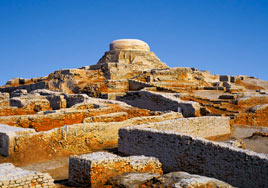 Morning depart for Moenjodaro, the Indus valley site and later continue to Sukkur. After settling in we shall visit the local bazaar of dates. o/n
Morning depart for Moenjodaro, the Indus valley site and later continue to Sukkur. After settling in we shall visit the local bazaar of dates. o/n
Moenjo-daro: (WHS) Locally Moenjo-daro means mound of the dead, was discovered by RD Banergji in 1919-20 while he was surveying the site of a Buddhist stupa (1st AD) found a flint stone on the site and reported that the site must be an ancient settlement. The regular archaeological diggings then started in 1924/25 unearthing surprisingly a site as old as 2500 BC. This was the time when Egyptian archaeological findings were at their zenith and were highlighted worldwide. Moejodaro was an important site of Harappan culture that survived as late as 1900 BC. The site revealed a well planned city inhabited by a race of Dravidian origins. It was revealed a highly cultured population living in a well planned and well settled life enjoying the riches of the time, wide spread trade relations with the outer world connected by sea and land. Indus Valley culture is recognized as the 3rd Civilization of the world. The town planning seen in Moenjodaro presented a well laid out city representing a rich culture with their own public systems. The total area of the city is reckoned as of 300 hectares supporting a population of 5000 souls. The city had two parts one was higher part with a citadel supported by city wall, the Great Bath, Assembly Halls, housing according to the category of position, city wells suggest city had enough water supply. There was also the city granary with a well planned storage foundations. The city lanes were well laid out with proper drainage and disposal of garbage. Among the prominent finding was a Priest bust, the dancing female, numerous steatite seals, pottery, toys, jewelry and numerous household artefacts. Surprisingly the bullock carts seen even today have not changed in style.
There is a well planned and well represented archaeological Museum near the site
Day 06: Sukkur – Sadiqabad – Bahawalpur – 300 kms
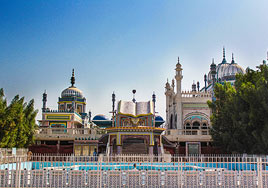 This morning we shall depart via the main highway of Pakistan following river Indus to Bahawalpur city. We shall make enroute a short diversion of 28 kms to see Bhong Mosque.
This mosque is known for its very interesting and beautiful architecture. The mosque
construction was started in 1932 by an aristocrat Sardar Raees Ghazi Mohammad of
Bahawalpur then a member of then Bahawalpur state. In the construction of mosque a lot
material and valuable decorative stones were imported from Europe, artisans were deployed in
carving on expensive sandal wood. This gave mosque an exquisite and elaborate décor giving
a unique character in decorative architecture. It was awarded Aga Khan Award of architecture
in 1986. The mosque is least known to visitors with only few have recorded seeing the mosque. Later we shall continue to Bahawalpur and on arrival transfer to hotel. o/n
This morning we shall depart via the main highway of Pakistan following river Indus to Bahawalpur city. We shall make enroute a short diversion of 28 kms to see Bhong Mosque.
This mosque is known for its very interesting and beautiful architecture. The mosque
construction was started in 1932 by an aristocrat Sardar Raees Ghazi Mohammad of
Bahawalpur then a member of then Bahawalpur state. In the construction of mosque a lot
material and valuable decorative stones were imported from Europe, artisans were deployed in
carving on expensive sandal wood. This gave mosque an exquisite and elaborate décor giving
a unique character in decorative architecture. It was awarded Aga Khan Award of architecture
in 1986. The mosque is least known to visitors with only few have recorded seeing the mosque. Later we shall continue to Bahawalpur and on arrival transfer to hotel. o/n
Day 07: Bahawalpur – Fort Derawar – Uch Sharif – Multan – 301 kms
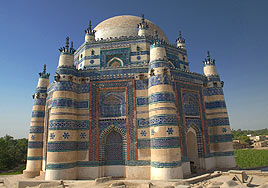 This is going to be an interesting day as we shall be discovering desert and an important town which played a vital role in 326 BC during Alexander the Great’s invasion of this part. We shall start for Fort Derawar deeper into Cholistan desert to see the massive fort. Derawar Fort is an impressive structure with 30 mtrs high walls covering a perimeter of 1500 mtrs. The fort was built in 9th century by local Hindu Raja as a tribute to Raja Rawal Deoraj of Jaisalmer. In the 18th century Nawab of Bahawalpur battled for this fort from local Rajput Raja and incorporated it in the state of Bahawalpur. The fort is partly habitable by local community or subjects of the former ruling family and an interesting section of the fort is dedicated to the former royal family of Bahawalpur Nawabs. They constructed a mosque in chaste Rajasthani decorative art in marble. Also there is a section dedicated as burial places with tombs of former Nawabs(Kings) and their kin. From Derawar we shall proceed to Uch Sharif – known for holiness as being the burial place of early saints and scholars mostly immigrants from Iraq and Iran. We shall visit the tomb of Bibi Jawindi which has been partially destroyed by the river stream but the impressive frontal part is still intact. We shall visit important shrines of saints who came here in 13th to 15th century escaping prosecution of ruling elite in Central Asia. Later we shall proceed to Multan and on arrival transfer to Hotel. o/n
This is going to be an interesting day as we shall be discovering desert and an important town which played a vital role in 326 BC during Alexander the Great’s invasion of this part. We shall start for Fort Derawar deeper into Cholistan desert to see the massive fort. Derawar Fort is an impressive structure with 30 mtrs high walls covering a perimeter of 1500 mtrs. The fort was built in 9th century by local Hindu Raja as a tribute to Raja Rawal Deoraj of Jaisalmer. In the 18th century Nawab of Bahawalpur battled for this fort from local Rajput Raja and incorporated it in the state of Bahawalpur. The fort is partly habitable by local community or subjects of the former ruling family and an interesting section of the fort is dedicated to the former royal family of Bahawalpur Nawabs. They constructed a mosque in chaste Rajasthani decorative art in marble. Also there is a section dedicated as burial places with tombs of former Nawabs(Kings) and their kin. From Derawar we shall proceed to Uch Sharif – known for holiness as being the burial place of early saints and scholars mostly immigrants from Iraq and Iran. We shall visit the tomb of Bibi Jawindi which has been partially destroyed by the river stream but the impressive frontal part is still intact. We shall visit important shrines of saints who came here in 13th to 15th century escaping prosecution of ruling elite in Central Asia. Later we shall proceed to Multan and on arrival transfer to Hotel. o/nUch – Alexandria:
After the successful invasion of the Hindu Fortress and abandoning the idea of further invasion of India Alexander the Great decided to much needed desire of his soldiers for the return to native land. But he ordered the Machatas, son of Phillip as the satrap(ruler) of the place to build a city at the confluence of two rivers – Indus and Beas(Indos & Acesines) The river since 326 BC has changed many courses but it is believed that the citadel founded by the Macedonians lies buried in the bed of rivers. We shall try to see the confluence of the rivers This point marks also the time when Alexander faced mutiny of his soldiers forcing him to return as it was becoming difficult to control his army rebellion.
Day 08: Multan – Harappa – Lahore – 354 kms
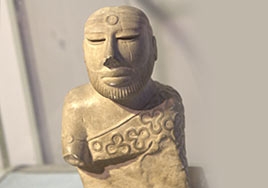 This morning we shall depart for another site of Indus valley culture older than the last site of Moenjodaro we saw earlier on our tour. On arrival at the site we shall visit excavated site and archaeological museum nearby. Later proceed to Lahore and on arrival transfer to hotel. o/n.
This morning we shall depart for another site of Indus valley culture older than the last site of Moenjodaro we saw earlier on our tour. On arrival at the site we shall visit excavated site and archaeological museum nearby. Later proceed to Lahore and on arrival transfer to hotel. o/n.
Harappa Indus Valley Site: The site of Harappa may have been accidentally excavated in 1857 when the plan for laying railway line was charted out and it was revealed that the local contractors supplied bricks from a site not knowing that they had hit a culture dating back to 2600 BC. The regular diggings at Harappa started in 1872-73 by Sir Alexander Cunningham and later the site has been excavated in different phases revealing a rich urban culture. Harappans traded with the outer world like the cities of Mesopotamia via the sea route while on the land recent discoveries have brought to light that it was connected by trade with several site in present Central Asia and Iran. The site was much larger where population may have exceeded twenty thousand souls. The city had proper planned sections with the great granary, bath houses, wells, workers sections. The city as usual was fortified with a strong mud wall similar to what we conjecture at Moenjodaro. The discovery of numerous beads and other jewelry ornaments throws light on the prosprous way of life led by the city. The recent studies have shown Dravidian languages may have links in Indus valley culture or this may be the old Dravidian culture. Harappan seal found in Karakum desert of Turkmenistan at Gonur Depe shows links in the later period of Bronze age sites and may have been also connected with Tepe Sialk which was in contact with Mesopotamian sites.
The end of Harappan culture is linked with migratory tribes from the west marauding the prosperous cities forcing the population into migration and depopulation by killings. This is around 1900 BC when disturbance started in the sites linked with Indus valley culture. The ransacking of towns must have led the local people into flight for safer destinations which could parts of India today.
Day 09: Lahore
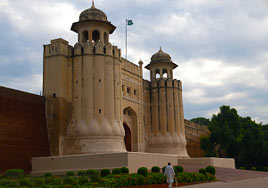 Today we shall spend full day visiting the Grand Mughal city, once capital of Maharajah Ranjeet Singh founder of the Sikh Empire. We shall start our visit with Badshahi Mosque – the grand mosque of its time is an imposing structure built by the last celebrated Mughal King Aurangzeb. After crossing steps with short stop at Sikh Baradari we proceed to Lahore Fort – the stretch of time has not diminished its grandeur. Lahore Fort is the best example of development of Mughal architecture through years starting with red sandstone buildings of Akbar’s period, the Hall of Public Audience of Emperor Jahangir’s period and the lay of his latest was his addition of Mughal gardens on Italian pattern. Emperor Shah Jahan’s period is pietra dura work on marble panels shows the richness in décor of Mughal period. This inlay work which appeared in 16th century in Italian décor found its way into Mughal architecture as well and was very nicely placed in important marble buildings. The Harem quarters of Shah Jahan’s period are exclusive ornament of Lahore Fort. The Naulakha pavilion with its Bengal style canopy was a special bungalow watching the nearby flowing Ravi river. The quarters and the Hall of Mirrors were all grand additions of Shah Jahan’s time. Our next will be walking down via the ‘Feel Pa’ Elephant steps – with mosaic that once In the afternoon we shall visit Old Bazaar – the quarters where aristocracy lived over the centuries with their ‘Havelis’ or big house reminds us of its richness culminated in one spot.We shall start our walk through busy streets with traffic jams is an opportunity to see local folks treading through the hustle bustle of the day. Our first stop will be at Sunehri Masjid or Golden Mosque was built in 1753 when Mughal rule was waning around late and Sikh rule was gaining ground. The mosque is conspicuous with its golden color domes however its interior is elaborately decorated with rich floral murals. After a short stop we continue walking through narrow lanes of the old bazaar to reach Wazir Khan’s mosque – this 17th century mosque named after royal physician of Shah Jahan is a glowing example of Central Asian styles in mosaic and tile work merged into Indian coloration of rich crimson, yellow, blue and turquoise colors of osaics. The mosque was completed in seven years and is regarded as one of the gems of Lahore city. We shall walk out from Old Delhi Gate to end our tour of the day
Today we shall spend full day visiting the Grand Mughal city, once capital of Maharajah Ranjeet Singh founder of the Sikh Empire. We shall start our visit with Badshahi Mosque – the grand mosque of its time is an imposing structure built by the last celebrated Mughal King Aurangzeb. After crossing steps with short stop at Sikh Baradari we proceed to Lahore Fort – the stretch of time has not diminished its grandeur. Lahore Fort is the best example of development of Mughal architecture through years starting with red sandstone buildings of Akbar’s period, the Hall of Public Audience of Emperor Jahangir’s period and the lay of his latest was his addition of Mughal gardens on Italian pattern. Emperor Shah Jahan’s period is pietra dura work on marble panels shows the richness in décor of Mughal period. This inlay work which appeared in 16th century in Italian décor found its way into Mughal architecture as well and was very nicely placed in important marble buildings. The Harem quarters of Shah Jahan’s period are exclusive ornament of Lahore Fort. The Naulakha pavilion with its Bengal style canopy was a special bungalow watching the nearby flowing Ravi river. The quarters and the Hall of Mirrors were all grand additions of Shah Jahan’s time. Our next will be walking down via the ‘Feel Pa’ Elephant steps – with mosaic that once In the afternoon we shall visit Old Bazaar – the quarters where aristocracy lived over the centuries with their ‘Havelis’ or big house reminds us of its richness culminated in one spot.We shall start our walk through busy streets with traffic jams is an opportunity to see local folks treading through the hustle bustle of the day. Our first stop will be at Sunehri Masjid or Golden Mosque was built in 1753 when Mughal rule was waning around late and Sikh rule was gaining ground. The mosque is conspicuous with its golden color domes however its interior is elaborately decorated with rich floral murals. After a short stop we continue walking through narrow lanes of the old bazaar to reach Wazir Khan’s mosque – this 17th century mosque named after royal physician of Shah Jahan is a glowing example of Central Asian styles in mosaic and tile work merged into Indian coloration of rich crimson, yellow, blue and turquoise colors of osaics. The mosque was completed in seven years and is regarded as one of the gems of Lahore city. We shall walk out from Old Delhi Gate to end our tour of the dayo/n
Lahore:
One of the largest cities of Indo-Pakistan sub-continent. The history of Lahore goes back to first millennium AD. The legend says it was founded by Lava the son of Rama. Hueng Tsang, the Chines pilgrim who visited India in 7th century AD mentions of a city by the river Ravi which could be Lahore. Bing situated on the cross roads to mainland India Lahore has been the battle ground of many invaders. After the fall of Hindushahi rulers at the hands of Mahmud of Ghazni, Lahore was captured by them in 1021 AD. Since then several Afghan rulers passed Lahore with every invasion from Mamluks to Tughlaks till it was wrested away by Babur the Great from the hands of Turkic Ibrahim Lodhi in 1524. This laid the foundations of Mughal rule in the years to come. Babur’s successor Humayun lost the city to Afghan King Sher Shah Suri in 1540 but was wrested back by Humayun with help of Safavids he recaptured Lahore in 1555 finally laid firm foundations of Mughal era in Hindustan (India). Onwards his son Akbar the Great made it as the Mughal capital in 1584. Akbar’s period is regarded as very strong in terms of cultural development of Lahore whereas it excelled in arts and crafts and architecture. His successor Jahangir’s period was not so stable as he faced his son’s rebellion supported by the Sikhs. Jahangir defeated his son and brought peace in the city. Jahangir’s likeness of the city was so great that he wished to be buried in Lahore. His wife the celebrated Nur Jahan built his mausoleum, regarded as an excellent of Mughal Architectural example. After Shah Jahan’s period of Lahore is yet another rich in arts and crafts. By the time of Aurangzeb the capital was mainly Delhi but he did continue the spirit of his predecessors by adding more buildings. After the fall of last of the Mughals Sikh rose to power and made Lahore as their Capital. Sikh Empire under Maharajah Ranjeet Singh captured a large territory but maintained a sentimental association with Lahore.
Day 10: Lahore
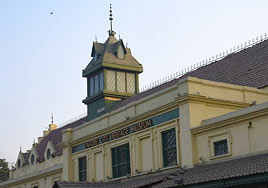 Continue our tour of Lahore – our first session will be dedicated to the visit of Lahore Museum – Lahore Museum is one of the few best museums of Indo-Pakistan sub-continent. It has got large galleries from Buddhist art of Gandhara to Mughal period. There is a rich collection of Mughal Art in miniatures and other school of arts existing at that time. Before we leave the museum we must pay attention to Zamzama canon was casted during the time of Ahmed Shah Durrani in 1757 left in Lahore on way to Kabul. Later it was used by the Sikhs and finally brought to rest at Tollington Museum in 1870. Popularly known as Kim’s gun owing to young Rudyard Kipling played his time with the gun since his father was the curator at the museum. Later it was shifted to its present location when Lahore Museum was formally opened. Later we shall proceed to the outskirts of Lahore to visit the mausoleum of Emperor Jahangir at Shahdara – this is an excellent building of Mughal architecture. We shall also visit the tomb of Nur Jahan – consort of Jahangir. Later we shall be in time for visit of Shalimar Gardens, built during the time of Shah Jahan in 1642. The gardens are in a spacious territory and was planned by the Persian architect Ali Mardan Khan with beautiful three terraces. o/n
Continue our tour of Lahore – our first session will be dedicated to the visit of Lahore Museum – Lahore Museum is one of the few best museums of Indo-Pakistan sub-continent. It has got large galleries from Buddhist art of Gandhara to Mughal period. There is a rich collection of Mughal Art in miniatures and other school of arts existing at that time. Before we leave the museum we must pay attention to Zamzama canon was casted during the time of Ahmed Shah Durrani in 1757 left in Lahore on way to Kabul. Later it was used by the Sikhs and finally brought to rest at Tollington Museum in 1870. Popularly known as Kim’s gun owing to young Rudyard Kipling played his time with the gun since his father was the curator at the museum. Later it was shifted to its present location when Lahore Museum was formally opened. Later we shall proceed to the outskirts of Lahore to visit the mausoleum of Emperor Jahangir at Shahdara – this is an excellent building of Mughal architecture. We shall also visit the tomb of Nur Jahan – consort of Jahangir. Later we shall be in time for visit of Shalimar Gardens, built during the time of Shah Jahan in 1642. The gardens are in a spacious territory and was planned by the Persian architect Ali Mardan Khan with beautiful three terraces. o/nDay 11: Lahore – Islamabad – 165 kms
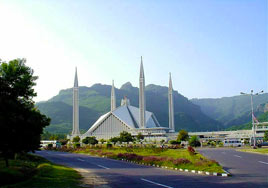 This morning we shall depart for Islamabad via the main highway with few stops enroute. On arrival transfer to hotel. Later orientation tour of Islamabad visit Shakerparian hills for grand view, Museum of Folk Heritage, drive past important Govt buildings, Diplomatic enclave, Supreme Court of Pakistan, Parliament house, Presidential Palace and Civil Secretariat buildings. Then we shall see one old model village of Saidpur to understand how Islamabad used to be and later see Faisal Mosque Farewell Dinner at local restaurant. o/n
This morning we shall depart for Islamabad via the main highway with few stops enroute. On arrival transfer to hotel. Later orientation tour of Islamabad visit Shakerparian hills for grand view, Museum of Folk Heritage, drive past important Govt buildings, Diplomatic enclave, Supreme Court of Pakistan, Parliament house, Presidential Palace and Civil Secretariat buildings. Then we shall see one old model village of Saidpur to understand how Islamabad used to be and later see Faisal Mosque Farewell Dinner at local restaurant. o/n
Day 12: Islamabad – Depart – Flt
Early morning transfer to Islamabad International Airport for your departure flight. Assistance on departure
Brief version for site:
Indus Saga - highlightsKarachi – Bhambore 1st century BC site – Thatta Makli largest necropolis tombs in red sandstone fret work – Mithi & Naukot Thar Desert – Hala pottery works – Bhit Shah mausoleum in best tiles – Sehwan Sharif Mysticism – whirling Darvesh – Moenjodaro Indus valley culture (3rd in the world) – exquisite Bhong Mosque – Bahawalpur – Fort Derawar – Uch the Alexandria on the Indus – Saints and tombs – Multan – Harappan site – Lahore the gem of Mughal cities.
Gallery
View the embedded image gallery online at:
https://ahutravelntourism.com/index.php?option=com_content&view=article&id=239&Itemid=673#sigProIddec30c2b99
https://ahutravelntourism.com/index.php?option=com_content&view=article&id=239&Itemid=673#sigProIddec30c2b99




